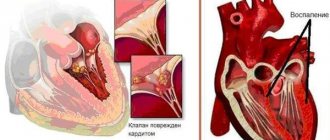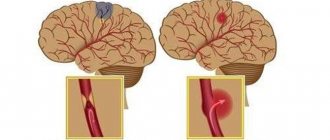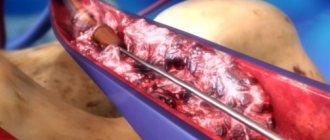Hemorrhagic shock (HS) is a critical condition of the body associated with acute blood loss, resulting in a crisis of macro- and microcirculation, a syndrome of multiple organ and multisystem failure. From a pathophysiological point of view, this is a crisis of microcirculation, its inability to ensure adequate tissue metabolism, satisfy the tissue need for oxygen, energy products, and remove toxic metabolic products.
The body of a healthy person can restore blood loss of up to 20% of the bcc (approximately 1000 ml) due to autohemodilution and redistribution of blood in the vascular bed. With blood loss of more than 20-25%, these mechanisms can eliminate the deficit of blood volume. With massive blood loss, persistent vasoconstriction remains the body’s leading “protective” reaction, and therefore normal or close to normal blood pressure is maintained, blood supply to the brain and heart is provided (centralization of blood circulation), but at the expense of weakening blood flow in the muscles of internal organs, including kidneys, lungs, liver.
Long-term stable vasoconstriction, as a protective reaction of the body at first, maintains blood pressure within certain limits for some time, and later, with the progression of shock and in the absence of adequate therapy, contributes to the consistent development of severe microcirculation disorders, the formation of “shock” organs and the development of acute renal failure and other pathological conditions.
The severity and speed of disorders during HS depends on the duration of arterial hypotension and the ascending state of organs and systems. With ascending hypovolemia, short-term hypoxia during labor leads to shock, as it is a trigger for impaired hemostasis.
Clinical characteristics of hemorrhagic syndrome
| I. Hematoma type (disturbance of the internal coagulation pathway of coagulation hemostasis) | II. Petechial-spotted (microcirculatory) type (disturbance of the platelet link of hemostasis, external coagulation pathway of coagulation hemostasis) | III. Mixed (bruise-hematoma) type (combined disorder of both platelet and coagulation components of hemostasis) | IV.Vasculitic purpuric type (pathology of the microvascular bed) | V.Angiomatous type (local vascular pathology) |
Typical location of hemorrhages
Most often, and this is about 55% of cases, hemorrhages occur in the putamental zone. Putamental bleeding occurs due to rupture of degenerated lenticulostriate arteries, which causes blood to enter the brain shell. The culprit of pathogenesis with such localization is usually long-standing hypertension. In some cases, bleeding from the putamentum breaks into the ventricular system, which is fraught with tamponade of the gastrointestinal tract and acute occlusive-hydrocephalic crisis.
The next most common location is the subcortical region (subcortical). Subcortical GIs are observed in 17%-18% of cases. As a rule, the leading sources of such hemorrhage are ruptured AVMs and aneurysms against the background of increased pressure. The subcortical zones involved in the hemorrhagic process are the frontal, parietal, occipital or temporal lobe.
The third most common place, where brain hemorrhage is determined in 14%-15% of cases, is the optic thalamus, or thalamus. Thalamic hemorrhages occur due to the release of blood from the blood vessel of the vertebrobasilar region. Pathogenesis can be associated with any etiological factor, however, as always, the involvement of hypertensive syndrome is significantly more often noted.
In fourth place (7%) in terms of frequency of development are pontine GIs. They are concentrated in the back of the brain stem, that is, in the pons. Through the bridge, the cortex communicates with the cerebellum, spinal cord and other major elements of the central nervous system. This department includes the centers for controlling breathing and heartbeat. Therefore, the bridge is the most dangerous localization of hemorrhage, practically incomparable to life.
Symptoms of hemorrhagic syndrome
The nature and localization of skin rashes during hemorrhagic syndrome determine the symptoms of this pathology.
The main symptom is prolonged bleeding that occurs as a result of injury or exhausting physical activity, severe overexertion, hypothermia or overheating, which can also occur spontaneously.
In every fifth case of the pathology, a rash of a different nature is observed, both small petechiae and large necrotic hematomas may appear, and angiectasias may occur.
Hemorrhagic syndrome can result from taking medications that affect the natural processes of platelets and reduce blood clotting. In addition, patients suffering from Werlhof's disease, hemophilia and prothrombin deficiency may also experience this pathology.
Diagnosis of ICH
The appearance in a patient receiving NAC of a sharp headache predominantly in the occipital region, nausea, vomiting that does not bring relief, non-systemic dizziness, as well as stunned consciousness is the basis for immediately excluding the diagnosis of ICH. Symptoms of hemorrhage usually develop suddenly [3, 7, 17–19], and meningeal syndrome and low-grade fever may develop first. Already in the first hours, signs of ICH can be determined using computer or magnetic resonance imaging (MRI). A highly sensitive technique is MRI using gradient echo [1, 20, 21].
Types of hemorrhagic syndrome
Violation of the internal coagulation pathway of coagulation hemostasis (hematoma type of bleeding)
Congenital and acquired afibrinogenemia
Deficiencies of different types of clotting factors cause different types of diseases called hemophilia, as well as other disorders that are not specific to a specific type.
More details
Disturbance of the platelet component of hemostasis, the external coagulation pathway of coagulation hemostasis (petechial-spotted type of bleeding)
Disturbance of the platelet component of hemostasis:
Disturbance of the plasma component of hemostasis
Thrombocytopenia
A condition characterized by a decrease in platelet count below 150•109/l, which is accompanied by increased bleeding and problems with stopping bleeding.
More details
Thrombocytopathy
A disease characterized by increased bleeding due to dysfunction of platelets (blood platelets that provide the initial stage of blood clotting) when their number is normal.
More details
Deficiency of factors II,V,VII,XI
Diseases associated with impaired coagulation; in these diseases, hemorrhages occur in the joints, muscles and internal organs, both spontaneously and as a result of injury or surgery.
More details
Combined violation of the platelet and coagulation components of hemostasis (mixed (bruise-hematoma) type of bleeding)
Etiology:
- Von Willebrand's disease (coagulopathy - impaired function of factor VIII, thrombocytopathy - impaired platelet aggregation)
- DIC syndrome (consumptive coagulopathy - decrease in all coagulation factors, hypofibrinogenemia, activation and depletion of fibrinolysis, thrombocytopenia, consumption thrombocytopathy)
Hemorrhagic syndrome:
- Petechial rash, ecchymosis, bleeding from the mucous membranes (nasal, gingival), postoperative, postpartum bleeding.
Disseminated intravascular coagulation
Impaired blood clotting due to massive release of thromboplastic substances from tissues.
More details
von Willebrand disease
A hereditary blood disease characterized by the occurrence of episodic spontaneous bleeding, which is similar to bleeding in hemophilia.
More details
Pathology of the microvascular bed (vasculitis-purple type of bleeding)
Petechial bleeding with exudative-inflammatory phenomena, foci of necrosis, hematuria, arthralgia, bleeding of mucous membranes.
Vasculitis:
- infectious, immune;
- systemic;
- hemorrhagic vasculitis (Schonlein-Henoch disease).
Hemorrhagic vasculitis
Systemic aseptic inflammation of the microvasculature with predominant damage to the skin, joints, gastrointestinal tract and renal glomeruli.
More details
Angiomatous bleeding
Angiomatous bleeding
One of the forms of hereditary vascular disease, characterized by a tendency to bleeding of the mucous membranes.
More details
Prognosis for ICH
The higher the INR level at the time of hospitalization, the greater the likelihood of increased hematoma size, residual neurological deficit and death [3, 17, 46, 65, 66]. Death occurs in 2/3 of patients with ICH if the INR at the time of hospitalization exceeds 3 [65]. A large volume of hematoma (> 50 ml), intraventricular extension of hemorrhage, and displacement of the midline structures of the brain are also associated with a poor prognosis [3, 6, 7]. According to AY Zubkov et al. [67], prognostically unfavorable factors are a low score on the Glasgow scale (Table 4) at the time of admission and a large initial volume of the hematoma. The development of neurological deficit does not depend in any way on the INR level at admission.
Diagnosis of hemorrhagic syndrome
A timely diagnosis will help a specialist prescribe effective treatment, and you will be able to make your blood vessels healthy once and for all. The diagnosis can be confirmed or refuted by passing a series of laboratory tests aimed at obtaining detailed information about the state of the blood. You will also need to conduct coagulation tests; during controversial situations, the diagnostician may perform a sternal puncture for in-depth diagnostics.
After obtaining a complete picture of the disease, determining its stage, causes and severity of hemorrhagic syndrome, treatment will be prescribed.
Treatment of hemorrhagic syndrome
The basis for choosing a treatment method for hemorrhagic syndrome is determining the cause of the disease, but there are the following key principles:
- Regardless of the cause, the patient is provided with emergency medical care to stop the bleeding. For this, vikasol, calcium chloride, vitamin C, and thromboplastin solution are used.
- If pathology occurs while taking potent medications, their discontinuation is mandatory.
- Local therapy for hemorrhages is carried out using dry thrombin, homeostatic sponges, aminomethylbenzoic acid (Amben).
- In case of heavy blood loss, transfusion of blood or its fractions may be necessary, preferably directly from the donor.
- Also, for hemorrhagic syndrome of various etiologies, serotonin preparations, for example, Dynaton, are used.
Prevention of hemorrhagic syndrome
The most important and fundamental part of the prevention of hemorrhagic syndrome is a complete medical examination for the timely identification and elimination of its possible causes.
Newborn premature babies need subcutaneous vitamin K and breastfeeding as soon as possible after birth.
The dietary nutrition of patients prone to this pathology should be based on increased consumption of vitamin K, as well as proteins, vegetables and fruits. In addition, such people need to avoid physical activity that leads to injury and injury.
You may also be interested in
Acute intestinal obstruction
A pathological condition that is characterized by a violation of the passage of the contents of the gastrointestinal tract in the direction from the stomach to the anus
More details
Intestinal paresis
Intestinal paresis is a condition that accompanies many serious diseases and is characterized by a gradual decrease in the tone of the intestinal wall and paralysis of the intestinal muscles
More details
Assessing the risk of developing ICH
It should be remembered that all patients have a risk of hemorrhagic complications during the treatment of NAC, but it is also quite obvious that the degree of risk varies among them. And the most difficult thing is to take into account all the facts “for” and “against” the use of NAC, i.e., ultimately making a decision about the balance of risk and benefit of treatment. To decide the feasibility and safety of anticoagulant therapy for a particular patient, it is necessary to assess the risk of hemorrhagic complications. Currently, the HEMORR2HAGES and HASBLED scales are most often used (Tables 1, 2).
Note. ALT – alanine aminotransferase, AST – aspartate aminotransferase, ULN – upper limit of normal, NSAIDs – non-steroidal anti-inflammatory drugs, AH – arterial hypertension.
Note. ALT – alanine aminotransferase, AST – aspartate aminotransferase, ULN – upper limit of normal; ALP – alkaline phosphatase, AH – arterial hypertension.
The HEMORR2HAGES scale was proposed by a team from the University of Washington to assess the risk of severe bleeding [14]. It was compiled based on an analysis of the results of NRAF (National Registry of Atrial Fibrillation). The analysis included the results of examination of 3971 patients with MA. During the year of observation, severe bleeding occurred in 162 of 3138 patients, of which 67.3% had gastrointestinal bleeding, 15.4% had ICH, and 17.3% had bleeding from other locations. In addition to the previously used risk factors, genetic factors were added to the HEMORR2HAGES scale. The risk of hemorrhagic complications increased significantly with an increase in the number of points by just one unit: 1 point – 2.2% per year, 2 points – 4.4%, 5 points or more – 12.3%. Comparison with previously proposed scales for assessing the risk of hemorrhagic complications showed the advantage of the HEMORR2HAGES scale.
Later, based on an analysis of data from the same register of patients (NRAF), another scale was developed to assess the risk of hemorrhagic complications in patients receiving antithrombotic therapy for atrial fibrillation, HAS-BLED [15]. This scale compares favorably with HEMORR2HAGES in its simplicity. Each factor is worth 1 point, with some exceptions. The maximum score is 9. According to the HAS-BLED scale, as well as HEMORR2HAGES, the risk of hemorrhagic complications increases significantly with increasing number of points: 1 point - 1.02% per year, 2 points - 1.88%, 3 points - 3 .74%, 4 points – 8.70%, 5 points or more – 12.5%. The predictive value of these two scales in patients taking NAC was similar. The HAS-BLED scale was included in the official recommendations of the European Society of Cardiology for the management of patients with atrial fibrillation as the main one for assessing the risk of developing hemorrhagic complications during anticoagulant therapy [16].
Calculating the risk of bleeding using the described scales and comparing it with the risk of thromboembolic complications (TEC) allows one to make an informed decision about the advisability of prescribing anticoagulants for each individual patient. Unfortunately, there are currently no specific scales for assessing the risk of ICH during therapy with warfarin or other NACs.
Medical care in hospital
All patients receive intensive therapeutic care at an early stage in a neuro intensive care hospital. Initial treatment measures are aimed at:
- normalization of microcirculation, hemorheological disorders;
- relief of cerebral edema, treatment of obstructive hydrocephalus;
- correction of blood pressure, body temperature;
- functional regulation of the cardiovascular system;
- maintaining water and electrolyte balance;
- prevention of possible seizures;
- prevention of extracranial consequences of inflammatory and trophic nature (pneumonia, embolism, pulmonary edema, pyelonephritis, cachexia, DIC syndrome, endocarditis, bedsores, muscle atrophy, etc.);
- providing respiratory support (if the patient needs it);
- elimination of intracranial hypertension in HI with dislocation.









